This was published 6 years ago
Japanese experience in Melbourne: Best restaurants, bars and shops for a Japanese cultural hit
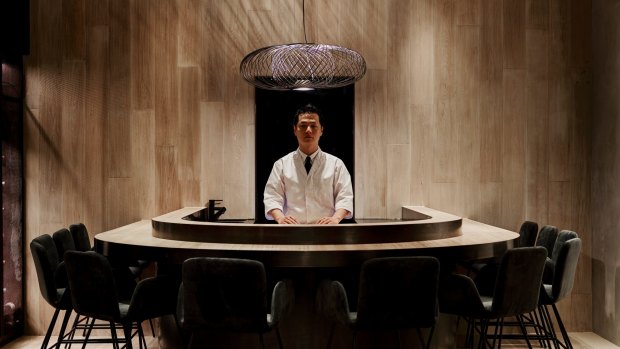
The Table at Kisume: a fine dining experience.
It ended less than a century before the advent of the revolutionary shinkansen, or bullet train, but the long and illustrious Edo period, when Japan was ruled by the Tokugawa shogunate, was an age when the reclusive Japanese first embraced the art of travel.
Although travel was strictly controlled by the shogunate, journeys with purpose from Edo, or modern-day Tokyo, to temples, shrines and sacred sites were permitted. However, there was always scope for pleasures on the way, specifically at the so-called post towns which sprang up to cater for the myriad needs of these new and enthusiastic domestic travellers.
It was within this milieu that Katsushika Hokusai, who would emerge as perhaps Japan's greatest artist, flourished. The prodigious printmaker and painter of the ukiyo-e school of Japanese art, with its depictions of subjects from everyday 17th century to 19th-century life, would win eventual international fame for his epic Thirty-six views of Mount Fuji series, including the instantly recognisable, The Great Wave off Kanagawa.
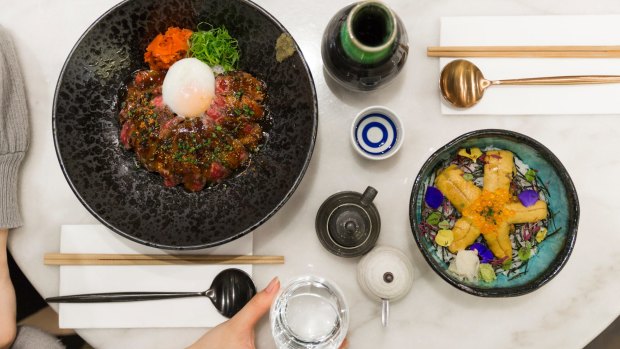
Dining at Calia, Emporium Melbourne.
I'm travelling, too, but just from Sydney to Melbourne, on a pilgrimage of sorts, to view Hokusai, the National Gallery of Victoria's comprehensive, if not exhaustive, exhibition of almost 180 of the artist's works. The exhibition runs until mid-October.
Although landscapes are a dominant feature of Hokusai's work, he was also fascinated by the daily lives of the Edo-era Japanese, as they attended to the multifarious tasks, including their travels.
Some of the works are also drawn from the NGV's own collection, bought on behalf of the institution by, and on the recommendation of, prescient European agents in the early 20th century. But most come from the Japan Ukiyo-e Museum in Matsumoto, a small, appealing regional Japanese city in central Honshu, the country's main island.
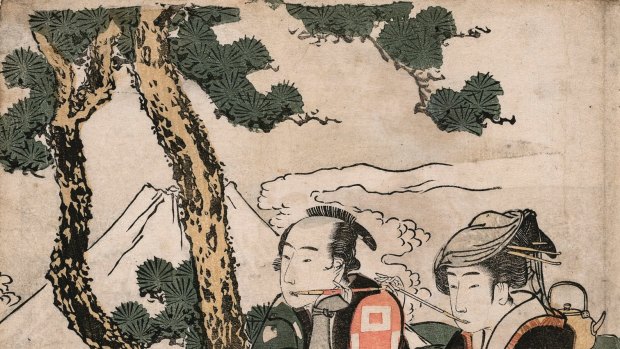
The Lovers Yosaku and Koman, twilight glow, c.1800, by Katsushika Hokusai.
After viewing Hokusai, being a devotee of Japanese culture and cuisine most of my adult life, I wondered where, had Hokusai (who died in 1849, aged 89) lived in the 21st century, one might take this great traveller on an imaginary visit to Australia.
Once, Sydney, with its large expatriate Japanese population, boasted the best Japanese restaurants in Australia but Melbourne has arguably displaced it in recent years, its unique laneways providing the perfect setting for intimate sushi and sake bars.
In fact, outside of Japan,Melbourne is emerging as one of the best places to immerse yourself in Japanese culture. And, with Hokusai running at the NGV until October, what better excuse could there be to sample the delights of the land of the rising sun in the land Down Under.
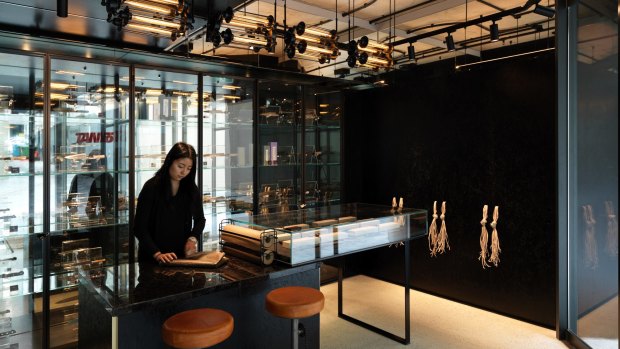
Knife shop.
THE SUSHI RESTAURANT
KISUME
TELL ME MORE The origins of sushi, at least in its familiar modern form, can be traced to the early 19th-century Edo period during which Hokusai lived his long life. One of the earliest fast foods, sushi was even sold at stalls by street vendors and would surely have been popular among pilgrims.
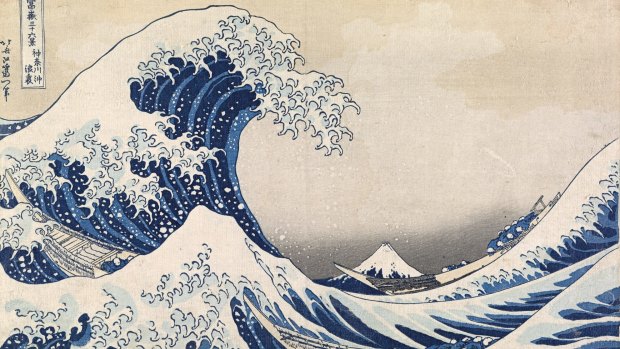
Katsushika Hokusai's The Great Wave off Kanagawa (detail).Credit: National Gallery of Victoria, Melbourne Felton Bequest, 1909
Sushi, as Hokusai would appreciate, has evolved into a virtual art form in its own right, as evidenced by Kisume, possibly Australia's flashiest Japanese food temple and a perfect accompaniment to a visit to Hokusai.
At this elaborate Flinders Lane restaurant, in the central business district spread over three levels, accomplished sushi and sashimi selections are presented by a phalanx of Japanese and Korean sushi chefs. The dishes are in classic blond-wood bento boxes with lids for a big reveal.
Arrive a little ahead of your reservation time, ideally at the sushi counter so you're on top of the action, for a pre-dinner sake or cocktail in the swish upstairs bar with walls adorned in edgy black and white photographic nudes.
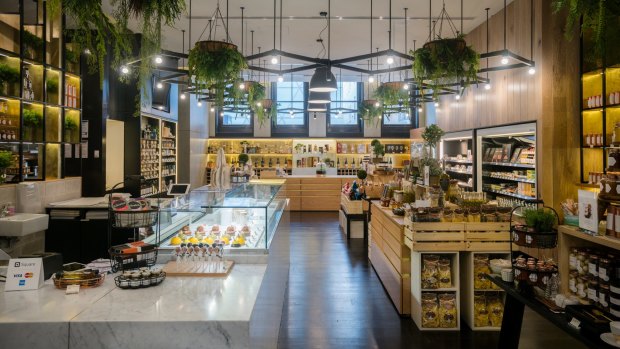
Calia, Lonsdale Street, Melbourne.
THE DETAILS 175 Flinders Lane, Melbourne. Phone (03) 9671 4888. See kisume.com.au
THE SAKE BAR
HIHOU
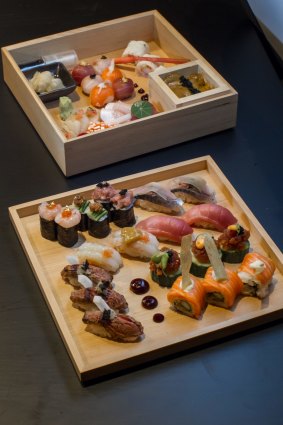
A deluxe sushi box served at Kisume Japanese restaurant.Credit: Scott McNaughton
TELL ME MORE Hokusai was a teetotaller throughout his life but he surely would have appreciated a moody, intimate bar like Hihou. Notoriously hard to find, it's near the top end of Spring Street. There is a discreet intercom, and a staff member lets you in, presumably after scrutinising you through a CCTV camera.
The brainchild of Simon Denton, who launched Izakaya Den, a fashionable Japanese pub-style restaurant elsewhere in the CBD, Hihou was designed by Denton Corker Marshall, the leading Melbourne architectural firm, with irregular, wrap-around wood panelling encasing the (raw) fish bowl-like windows through which glimpses of Treasury Gardens can be enjoyed.
The seating and tables at Hihou are almost as low as the lighting levels and, although there's Kappo, a full restaurant, at the basement level beneath Hihou, you can still order excellent snack-like food in the bar – stocked with fine sakes and shochu. Dishes include moreish mini hotdogs with a delicious Japanese Arabiki-style sausage encased in a sesame brioche bun.
THE DETAILS
Hihou, Level One, 1 Flinders Lane, Melbourne. Phone (03) 9654 5465. See hihou.com.au
THE JAPANESE KNIFE SHOP
TANTO
TELL ME MORE Tanto, one of Melbourne's most novel, though impressive, retail outlets, is one place on Hokusai's imaginary visit that he would surely appreciate since all manner of blades would have been a dominant feature of the Edo period.
Pitched mainly at specialist local chefs aware that the Japanese produce the world's finest kitchen knives, Tanto stocks precision implements which draw on a 10th-generation craftsman pedigree dating to the sword-carrying samurai era.
Part of the modern QT Melbourne hotel complex on Russell Street in the city's lively CBD, Tanto is in the same laneway as Hot Sauce, a bar-style eatery specialising in Japanese and Korean street food. Even if you're not in the market for a truly cutting-edge knife this "only in Melbourne" shop is well worth a look.
THE DETAILS QT Melbourne, 133 Russell Street. Melbourne. Phone (03) 8636 8800. See qthotelsandresorts.com
THE TEXTILES AND CRAFT STORE
KIMONO HOUSE
TELL ME MORE With Japan being so isolated from the rest of the world until the 19th century, Hokusai would be impressed by how much international interest there is not just in Japanese cuisine, but in its superb textiles and crafts.
Kimono House is owned and managed by Leanne O'Sullivan, a Melburnian who once lived and worked in Japan. Nowadays she spends two months each year on buying and research trips that form the basis of the textiles sold at Kimono House.
The store is in the Nicholas Building, an atmospheric 1926 "Chicago school" heritage-listed building that has become a hub for Melbourne's creatives. It's from there that O'Sullivan also conducts classes in traditional Japanese handicrafts, such as water-based woodblock printing and kimono-dressing, drawing on garments from her own collection.
THE DETAILS
Kimono House, Level Two, Nicholas Building, 37 Swanston Street, Melbourne. Phone 03 9639 0565. See kimonohouse.com.au
THE JAPANESE SALON AND STORE
CALIA
Hokusai was known for his sweet tooth, and after Japan opened up to the world, his countrymen became some of the best pastry chefs outside France, and remain so.
At Calia, a new salon-like dining and retail establishment at Emporium, an upscale mid-city shopping centre, the Gallic-style sweet treats come from the well-regarded Bibelot in South Melbourne.
But the food on the menu is emphatically savoury and Japanese, including the Calia wagyu bowl, comprised of single origin premium grilled wagyu beef with a 63-degree egg.
Sign off with a wonderfully fluffy Hokkaido cheesecake with yuzu jelly (Hokusai would surely adore it). To the side of this open-plan restaurant is an ambitious retail section stocking those French pastries, as well as a fine selection of quality sake and condiments, including wasabi mustards.
THE DETAILS
See calia.com.au; emporiummelbourne.com.au
FIVE MORE GREAT JAPANESE PLACES TO TRY IN MELBOURNE
MINAMISHIMA, RICHMOND
Good luck securing a seat at this inner-city Richmond exclusive restaurant, a three-hat recipient in The Age Good Food Guide.. At Minamishima, which some consider to be Australia's best Japanese restaurant, the omakase (chef's selection) of sushi master Koichi Minamishima is de rigueur. Choose from a 15-course sushi omakase at the long bar, or a handful of shared dishes followed by 10 courses of individual sushi. See minamishima.com.au
SUPERNORMAL, CITY
Although the menu at this exceedingly popular designer canteen, where queues can form after 5pm all the way out onto fashionable Flinders Lane, is pan Asian, the aesthetic and approach are unequivocally Japanese, down to its excellent sake menu and even the typography in its signage. On the menu, Japanophiles will find plenty to satisfy them, including a good range of sakes. See supernormal.net.au
NOBU, SOUTHBANK
This long-standing branch at the Crown casino complex at Southbank, overlooking the Yarra River and its promenade, of Nobuyuki "Nobu" Matsuhisa's restaurant empire, is one of only two in Australia (the other is in Perth). It's known for its mostly successful fusion cuisine blending traditional Japanese dishes with Peruvian ingredients. See noburestaurants.com/Melbourne
KENZAN, CITY
Purists, unimpressed by the flamboyance of many modern-day Japanese restaurants, will appreciate the unapologetically traditional Kenzan. Inside Collins Place at the so-called Paris end of Collins Street, Kenzan, named after the renowned Edo-period potter, Ogata Kenzan, opened in 1981 and remains highly rated. See kenzan.com.au
SAKE RESTAURANT & BAR, CITY
Sake, which began life in The Rocks, Sydney, and which has since developed into a mini Nobu-like chain under the auspices of the Rockpool Dining Group, has opened yet another venue, Sake Flinders Lane, in the thick of Melbourne's restaurant-intensive CBD. The two-storey venue includes a dining counter combining a sushi bar and robatayaki grill serving Japanese staples such as yakitori. See sakerestaurant.com.au
TRIP NOTES
MORE
SEE
Hokusai is on at the National Gallery of Victoria (NGV), 180 St Kilda Road, until October 15. Tickets for adults cost $16. The NGV is open from 10am to 5pm daily. See ngv.vic.gov.au
STAY
Four Points by Sheraton Melbourne Docklands is a new modern hotel in the redeveloped wharves precinct to the west of the CBD. Doubles start from $130 a night. 443 Docklands Drive, Docklands, Melbourne. Phone 03 8578 0000. See fourpointsmelbournedocklands.com
BUY
Limited edition, high quality prints of Hokusai's work, marking the NGV's major exhibition, are available for purchase from The Store, Fairfax's online retail arm. See thestore.com.au
Anthony Dennis visited as a guest of Visit Victoria and the National Gallery of Victoria.
Sign up for the Traveller Deals newsletter
Get exclusive travel deals delivered straight to your inbox. Sign up now.